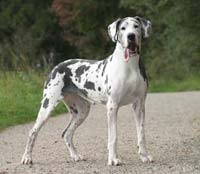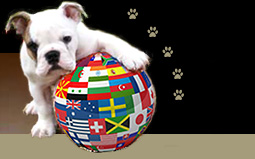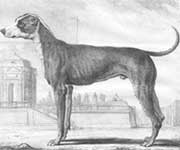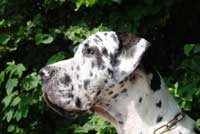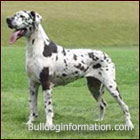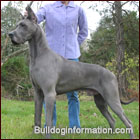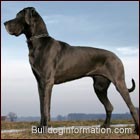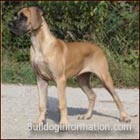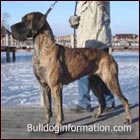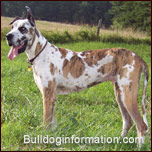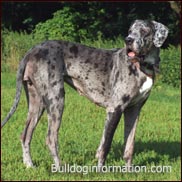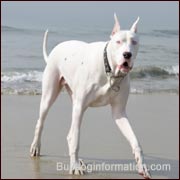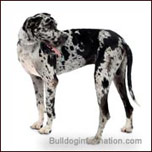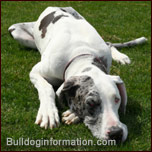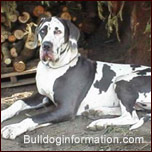The Great Dane is a giant, strong dog of a German breed, also known as the 'Apollo of Dogs', in reference to its majectic and elegant stature.
Despite its name, the breed is not of Danish origin, but German. In many other languages the breed is indeed known as German Mastiff: Dogue allemand in French, Deutsche Dogge (in German), Dogo Aleman in Spanish.
The ancestors of the German Mastiff or Great Dane were the ancient Bullenbeisser (bull-biter), which in turn descended from the Saupacker (boar-hunter). These dogs were heavier, less stream-lined dogs, bred for ferocity rather than looks. The Great Dane has been selectively bred for docility and was very popular in Germany during the 1800s. Otto von Bismarck, a fervent admirer of these dogs, crossed Molossers of Bavaria with the dogs of the North to produce the Dane we know today.
It was the French naturalist Count Buffon (1707-1788) who first described the breed "Grand Danois", in his Histoire Naturelle. However, it is not sure whether he actually coined the name. Some sources believe that the term "danois" comes from the Old French word "danoisé" (spotted).
Great Dane
(German Mastiff, Deutsche Dogge, German Boarhound, Ulmer Mastiff, Danish Dog, Alano, Grand Danois)
There are also references to a 'Petit Danois', a similar dog, but smaller in size, considered by some to be the ancestor of the Dalmatian. However, the illustrations in Buffon's work of the Grand and Petit Danois do not show spotted dogs.
Interesting is that Buffon considered the Great Dane, the Hound, the Mastiff and the Irish Wolfhound as varieties of one and the same breed that evolved under different climatic conditions. His theory was that the (French) mastiff (matin) produced a stockier variety, the Great Dane, under the influence of the colder climate of the North.
Unlike most other molosser breeds, the Great Dane has no loose skin in the neck region. The chest is very deep and V-shaped. Traditionally, the Great Dane's ears were cropped.
The breed holds the record for the tallest dog in the world with Gibson, a Great Dane living in Sacramento, California, which has a shoulder height of 42.6 inches.
Whether the Grand Danois described by Buffon is actually the direct ancestor of the modern Great Dane remains unclear. In the early 1900s some authors, like Bylandt in his treaty 'Dogs of all Nations', still considered the Deutsche Dogge and Great Dane (Danske Hund) as being two different breeds. It was not until 1937 that the breed was recognized by the FCI under the name Deutsche Dogge, although the German breed club recognized the breed under that name as soon as 1877. The Great Dane owes much to the German breeders and the first breed club in Germany. They greatly contributed to the development of the breed and wrote down the first breed standard. However, the first dogs imported to England were of Danish stock, hence probably the reason why they are still known today as 'Great Danes' in the English-speaking world.

However, as a breed, the Great Dane is not the tallest dog breed among canines. On average the Irish Wolfhound is slightly taller with 32 to 34 inches (80-86cm).
Coat Colors
The original Great Dane standard mentions five coat colors : black, harlequin (black and white), fawn, brindle and blue. The AKC also recognizes a sixth color (pattern), Mantle, also known as 'Mantle Tiger' or 'Boston'.
In England, the breed club was founded in 1885. The Great Dane Club of America was formed in 1889.
In the mantle pattern the black part appears like a mantle or blanket over the back, skull and ears, leaving the legs, throat and neck partially white. In Mantle Danes white markings usually include a white muzzle with or without white blaze, white socks or stockings, white tipped tail, white collar and white chest. White markings should never extend so far upwards as to be found above the flanks, and any disruption in the blanket should be penalized. Head and body should never be predominately white and mantled danes should never be more than 30% white alltogether. Mantled color patterns also exist with a fawn (mantled fawn), blue (mantled blue) or merle mantle (mantled merle). Black-mantled Danes are also known as Bostons, for their similarity to the black-and-white pattern of the Boston Terrier.
Special types of harlequin colors are grey-tiger (grey with black patches), fawnequin (white with fawn patches), brindlequin (white with brindle patches), merlequin (white with brown, grey or blue merle patches, also spelled as 'merlikin') and blue harlequin (white with solid blue patches). The black patches should never be so large as to give the appearance of a blanket, nor so small as to give a stippled or dappled effect. The patches should appear torn and irregular and be evenly distributed over the body. If only few patches are present and unevenly distributed over the body and if they show smooth edges, the color pattern is called piebald. It is not a desirable color pattern in Great Danes.
Multi-colored tigers, grey-tigers, whites, merles and piebalds or parti-colored danes are considered a disqualification and are not admitted in the show ring. Piebald danes are either undermarked Mantledanes or white Danes with colored patches that do not have the distinctive, irregular torn pattern as seen in the Harlequins. All colors and color patterns other than the six recognized ones result from breeding colors outside their categories and carry undesirable color genes or undesirable combinations of genes, reason why they should not be further bred. Only certain pedigreed whites can be bred with specific blacks or harlequins to produce harlequins.
.
.
.
.
Original idea, design and development by C. Marien-de Luca.
Photos of the Dog Breeds of the World sphere of flags by Mark Stay. No part of canininformationlibrary.com may be copied, distributed, printed or reproduced on another website without the owner's written permission.
Character and Temperament
Grand Danois, according to Buffon
Petit Danois, according to Buffon
Great Dane Head study
Ike vom Adebar
First three coat color photos by Deutsche Doggen vom Adebar,
blue Dane 'Fred' (left) by Von Knopf Danes and black dane (right) by Ralf Weigel.
Great Dane (merle)
Merles do not have the harl gene
Photo: Anna Bakulina
Great Dane (fawnequin)
Photo: Jana Thompson
Merlequin or piebald merle
Photo: Chris Bernard
Other colors and color patterns are solid white and merle (a mouse gray background with small, torn, black and/or blue speckles).
Great Dane (grey-tiger)
Photo: Eric Isselée
Great Dane (white),
all true whites are double merles, also known as 'White Tigers'. Photo: Paul Erickson
Great Dane (brindlequin) 'Duke'
Photo: Christi Stranz
Great Dane (blue harlequin)
Photo: Vardanel Great Danes
Great Dane (Blue Mantle)
Photo: Vardanel Great Danes
Despite their impressive and robust appearance, Great Danes are not outdoor dogs. They are sweet and loyal dogs who love being around their human family. They get along well with other dogs, and even with cats.
Ike and Karthago vom Adebar
Great Dane (fawnequin)
Photo: Jana Thompson
Danes are a giant breed of dogs, and many end up in rescue with the statement "I didn't know he was going to get this big." So, please make sure to research this breed fully before obtaining a puppy.
Further Reading:
- BECKER Frederick, The Great Dane - Embodying a Full Exposition of the History, Breeding Principles, Education, and... (1933)
- BUFFON (Georges Louis Leclerc , Comte de), Histoire Naturelle, Générale et Particulière, avec la Description du Cabinet du Roi. Tome Cinquième. Le Chien avec ses variétés (published from 1749 to 1788)
- BYLANDT (Comte Henri de), Les Races de chiens. Leurs points, description, types, qualités, aptitudes et défauts (ca.1900)
- Understanding color breeding in the Great Dane by the GDCA
- Standard Accepted Coat Color Genetics in Dogs by JP Yousha
- Danois ou Dogue allemand ? ('Great Dane or Deutsche Dogge', in French)
- Gibsondog.com: the world's tallest dog
- Great Danes are not a dog for everyone by Christi Stranz
Great Dane:
A Comprehensive Guide to Owning and Caring for Your Dog (Kennel Club Dog Breed Series) (Hardcover)
by S. William Haas
More information:
The Great Dane:
Embodying a Full Exposition of the History, Breeding Principles , Education, and Present State of the Breed
(A Vintage Dog Books Breed Classic)
by Frederick Becker
A reprint of a book frist published in 1933 covering all aspects of the Great Dane: history of the breed, buying, breeding, feeding and showing. photographs of champion Great Danes of the day, a full descriptive write-up of each dog and their pedigrees.
More information:
Great Danes
by Joe Stahlkuppe


